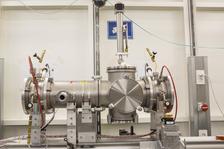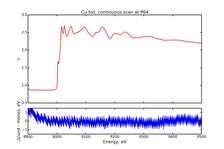Basic XAS Experiment:
Ionchamber for I0 → Vacuum Sample Cross → Ionchamber for I1
Transmission mode
This mode is mostly used for highly concentrated samples (> ca. 1 wt. %).
Two ionization chambers are used for the detection of the incident I0 and transmitted beam intensity I1 .
Next, the absorption coefficient is calculated:

With 3 ionization chambers it is possible to measure two spectra for the sample and the reference simultaneously.
At P64 the continuous monochromator + undulator scans are implemented.
So, the time for each EXAFS scan is reduced down to 1-5 min.
Fluorescence mode
If the sample is highly diluted or the transmission mode is impossible for some reason the fluorescent mode can be used instead.
Here, the absorption coefficient is measured via the ratio of the fluorescence signal If and I0 :

If the fluorescence energy is in the range of 4-12 keV and the concentration of the element in the sample is not less than 100 ppm, the optimal choice would be to use the Passivated Implanted Planar Silicon (PIPS) Detector (Canberra) . EXAFS scan still can be done in 1-5 min.
For lower concentrations a 4-pixel SDD can be used. It has a maximum counting rate of about 106photon/s. It is still possible to collect data in continuous scanning mode.







